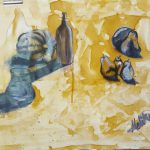Hilmi ran our first workshop for the year – a Drawing Workshop using Ink and Shellac. It was a marathon workshop, where students created a still life, beginning with charcoal, then two layers of shellac and finished with black ink and white paint!
Hilmi began the workshop teaching students some of the fundamentals of drawing. Students were to choose a number of items of still life that Hilmi had meticulously arranged, with black sheets behind them, which Hilmi explained was important because it creates the shapes of the still life. You see the shape of something by looking at what is behind it, and a dark surface makes this easier.

After students finished the drawing in pencil, they then used charcoal to enhance the dark and light tones within the image.
Once students felt they had a finished sketch, Hilmi put down a big plastic sheet, and made sure everyone wore gloves for, what students felt, was a daunting, yet fascinating process. They laid their works on the plastic sheet and poured shellac all over the page, moving around and smoothing out the shellac with small spatulas. Students were hesitant to pour the runny mixture on the thin paper, however the shellac sealed the charcoal drawing beneath and eventually created a hard surface; changing the images instantly! Students added two layers and then left them to dry for half an hour. If you are familiar with Hilmi’s mixed media works using shellac, he normally uses at least eight layers of shellac!


Once the images were dry, the next step was to add ink in the darkest areas, and diluted ink for the mid-tones. Painting over the shellac was unlike anything they had experienced; the new texture of the paper was unpredictable; there were bubbles, rough and smooth areas, which made it very interesting, yet challenging to apply the ink! The final part of the workshop saw students adding white to the lightest areas, which was what Hilmi called creating ‘magic’. It really did lift the still life images off the page!
If you’d like to join one of our next workshops, you can view them here.






